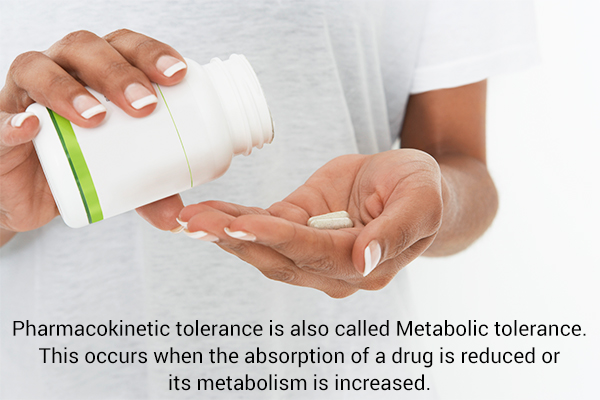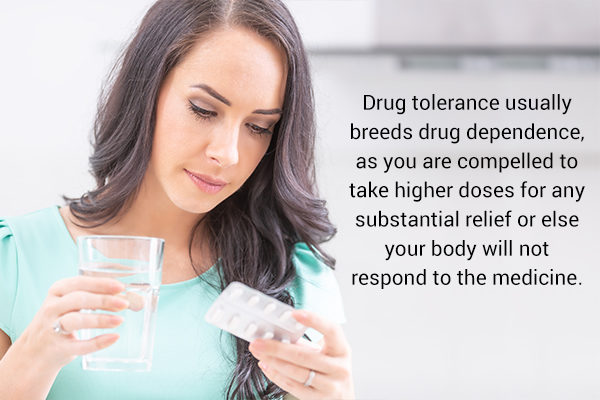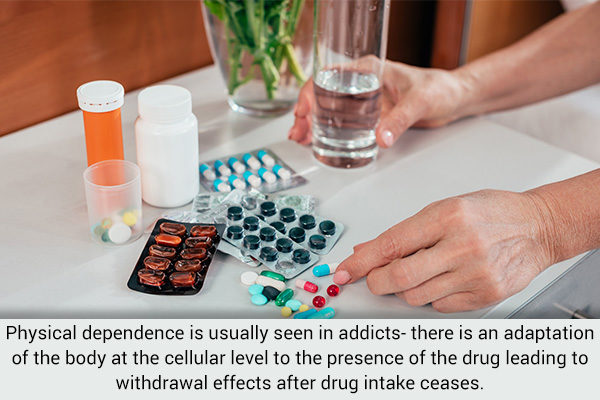In this article:
The words tolerance, dependence, and addiction have been used interchangeably, but there are important medical differences in each of these definitions that set them apart.

This article aims to shed light on the important differences of these conditions and provide information on when to seek medical attention.
Definition of Drug Tolerance
Tolerance to drugs is a condition that involves a decrease in the effectiveness of a drug after repeated use. This means that a user would have to increase the dose of the drug to experience the same effect.
The general public tends to associate drug tolerance with illegal drugs such as cocaine, but the fact is that tolerance can occur with prescription drugs such as painkillers.
Here are some facts about drug tolerance:
- Tolerance is typically seen with drugs that are active on brain receptors and stimulate the reward pathway. These drugs include alcohol, morphine, barbiturates, lysergic acid diethylamide (LSD), and amphetamines.
- Tolerance does not necessarily develop uniformly for all actions of a drug. For instance, morphine users develop tolerance to the “euphoric” effects of the drug but not to its effects on respiratory depression.
- The tolerance that develops toward centrally acting drugs such as alcohol and morphine are frequently associated with physical and psychological dependence.
Types of Drug Tolerance
The main types of drug tolerance include:
1. Innate tolerance
This is genetically determined by a lack of sensitivity toward a drug when it is first administered.
For example, African Americans are genetically more tolerant toward certain drugs used to dilate the pupils, such as ephedrine. That would mean that higher doses of ephedrine would be required to dilate their pupils.
2. Acquired tolerance
This kind of tolerance develops after repeated use of a drug that was initially producing a response. This can develop due to pharmacokinetic or pharmacodynamic reasons, which will be discussed below.
3. Acute tolerance
Acute tolerance, or tachyphylaxis, is the development of tolerance after repeated dosing of a drug in quick succession. This kind of tolerance is rarely seen in clinical therapy, as repeated dosing in short intervals is not customary.
Cocaine, when used in successive doses, leads to a disparity between the demand and supply of the excitatory catecholamines at neurons (producing the euphoric effects), leading to the development of tolerance in minutes.
4. Chronic tolerance
Long-term exposure to a drug level leads to body adaptations that develop over weeks or months. Patients suffering from chronic pain develop tolerance to the analgesic effect of opioids, leading to a need to increase the dose.
Chronic tolerance can be dangerous as it can be associated with the inability of the body to function without the presence of the drug in the system.
5. Cross-tolerance
Drugs belonging to the same class can exhibit cross-tolerance. A person who is tolerant to morphine experiences the same for heroin and other narcotic analgesics. Similarly, an alcoholic can experience the ineffectiveness of benzodiazepines, which are commonly used in anti-anxiety and sleep-aiding medications.
Mechanisms of Drug Tolerance

Drug tolerance develops through the following mechanisms. (1)
1. Pharmacokinetic tolerance
Also called metabolic tolerance, pharmacokinetic tolerance occurs when the absorption of a drug is reduced, or its metabolism is increased.
For instance, chronic alcoholics have a thickened stomach lining due to the long-term effect of consuming alcohol, which in turn decreases the absorption of alcohol. Barbiturates may also be subjected to increased metabolism, leading to decreased effectiveness at the same dose.
2. Pharmacodynamic tolerance
Studies on tissue receptors have demonstrated that during repeated administration of a drug, there is a decrease in the number of functional receptors or impairment of the downstream signaling pathway post-drug-receptor interaction. Both these effects at the cellular level can result in decreased response to the drug administered.
Examples of drugs that cause pharmacodynamic or cellular adaptive changes are morphine and its analogues, caffeine, and nicotine. (2)
What Is High Tolerance?
There is no standard definition of high tolerance, and it is defined similarly to tolerance. High tolerance to alcohol comes with an increased risk of cancer, high blood pressure, and sexual dysfunction.
Difference Between Tolerance and Dependence

One of the serious after-effects of tolerance is the development of dependence. This is especially dangerous when taking drugs that stimulate the reward system in the brain, reinforcing “drug-seeking behavior.”
The neurons in a person taking such drugs adapt so much to the drug being in the system that once stopped, the body reacts almost violently, causing distressing symptoms. Withdrawal syndrome ensues. (3)(4)
Physical dependence on a drug develops when it is associated with three or more of the following:
- Physiological changes in the body leading to tolerance
- Withdrawal symptoms after the drug is stopped
- Persistent desire or craving for use
- Use of a drug in larger amounts than medically prescribed
- Continued use despite the impact on personal, family, and social life or legal implications
Examples of drugs that cause severe physical dependence and life-threatening withdrawal are:
- Opioids
- Barbiturates
- Alcohol (heavy use)
Psychological dependence is a milder form that may or may not involve tolerance to the drug, and the withdrawal is not life-threatening. (5)
Tolerance and Resistance
Drug resistance is the unresponsiveness of microorganisms to an antimicrobial agent after repeated use. (6)
Natural resistance is seen in bacteria that cause tuberculosis. These bacteria are unresponsive to drugs such as tetracyclines or cephalosporins but respond to specific agents such as isoniazid and rifampicin.
Acquired resistance is a more menacing problem, especially in hospital settings. It is the subsequent development of tolerance to an antimicrobial agent that was initially effective.
Methicillin-resistant Staphylococcus aureus (MRSA) is a prime example of bacteria that have acquired resistance to some antibiotics.
Drug Addiction

In the United States, addiction to alcohol, nicotine, and illicit drugs account for more than $740 billion a year in costs related to healthcare, crime, and lost productivity.
Addiction belongs to the severe end of the spectrum of substance use disorders and can be broken down into these three components:
- A long-term relapsing problem accompanied by a compelling need for drugs
- Sustained use regardless of the harmful effects
- Lasting changes in the brain
Addiction occurs due to multiple factors:
- Genetic susceptibility
- Socioeconomic status
- Family environment
- Accessibility to drugs
Physical dependence is usually seen in addicts – there is an adaptation of the body at the cellular level to the presence of the drug, leading to withdrawal effects after drug intake ceases. (7)
The following example underscores the subtle difference between addiction and dependence:
Many people dependent on caffeine experience withdrawal effects, such as headaches, fatigue, and irritability, if they miss their morning cup, but this would not cause them to behave irrationally to obtain it. In addicts, despite knowing the negative effects, there is compulsive, destructive behavior to procure the drug.
Risks of Drug Tolerance
Summarizing the definitions explained above, the risks of drug tolerance include:
- Physical dependence
- Psychological dependence
- Withdrawal symptoms
- Addiction
- Death due to overdose
Management and Treatment of Drug Tolerance
Treatment of drug dependence requires medical intervention where the goal is to achieve a “drug-free state” and prevent a relapse of drug use. This goal can be achieved through pharmacotherapy, rehabilitation, and psychosocial intervention.
Treatment strategies include:
1. Substitution of the abused drug with a similar one
Substitution of the abused drug with a similar drug that is longer acting and slow tapering to minimize the withdrawal effects. An example is methadone substitution in heroin addicts.
2. Using an antagonist
Using an antagonist that blocks the pleasurable effects of the drug and prevents relapse. An example is naltrexone for opioid addiction.
3. Aversion therapy
Aversion therapy, which involves using a drug that produces an unpleasant response after intake of the abused drug. An example is disulfiram in alcohol aversion therapy.
Medication-Assisted Treatment (MAT)
Medication-assisted treatment can be understood by taking the example of opioid dependence. In 2018, 10.3 million people aged 12 or older misused opioids, and the vast majority of people misused prescription pain relievers. (8)
The FDA has approved certain medications such as methadone, buprenorphine, and naltrexone to treat addiction to morphine, codeine, oxycodone, and hydrocodone. The treatment duration can last months, years, or a lifetime. (9)
Methadone and buprenorphine act by reducing craving, withdrawal symptoms, and the pleasurable effects of other opioids. Naltrexone effectively blocks the pleasurable effects of opioids but works only after treatment with methadone has been initiated, and the patient is opioid-free for 10 days.
Final Word
Tolerance and dependence are common terms discussed under drug addiction. The development of tolerance results in the patient thinking that the drug is “not working.” This may lead to increasing the dose of the drug to produce the same effect.
Almost all dependence-producing drugs activate the reward-reinforcement pathway that releases large amounts of dopamine (pleasure neurotransmitter).
Ultimately, the difference is that addiction is a mental health disease, whereas tolerance and dependence are physical responses to drug abuse. Treatment of dependence and addiction requires specialized medical interventions and rehabilitation to prevent relapses.
- Was this article helpful?
- YES, THANKS!NOT REALLY


